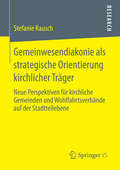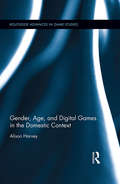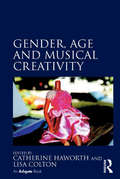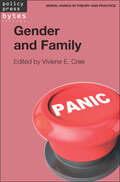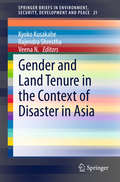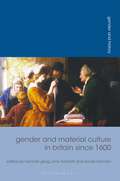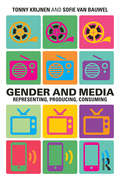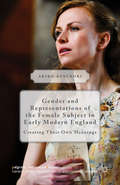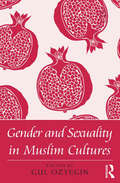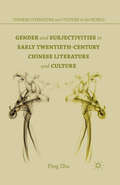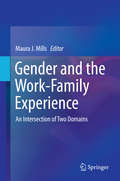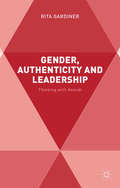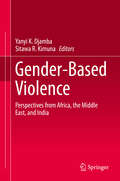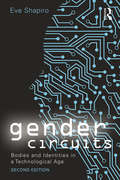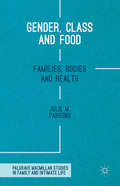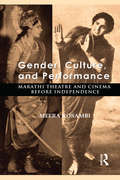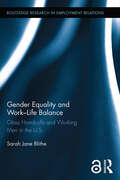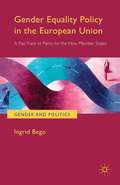- Table View
- List View
Gemeinwesendiakonie als strategische Orientierung kirchlicher Träger: Neue Perspektiven für kirchliche Gemeinden und Wohlfahrtsverbände auf der Stadtteilebene
by Stefanie RauschStefanie Rausch erörtert und problematisiert das Spannungsfeld zwischen der „verfassten Kirche“ und dem „Dienstleistungsunternehmen Diakonie“ sowie den von Armut und Ausgrenzung betroffenen Menschen. Entgegen dem schier unaufhaltsamen Trend zur neoliberalen Monetarisierung kirchlichen Engagements sucht sie einen praxisnahen Erfolgsweg in der Logik „lebensdienlichen Wirtschaftens“ im Rahmen der Gemeinwesendiakonie. Vor dem Hintergrund der Sozialwirtschaftslehre und ihrer Praxiserfahrungen als Geschäftsführerin eines Diakonievereins entwickelt sie innovative Modelle der Kooperation und Vernetzung auf lokaler Ebene.
Gender, Age, and Digital Games in the Domestic Context (Routledge Advances in Game Studies)
by Alison HarveyWestern digital game play has shifted in important ways over the last decade, with a plethora of personal devices affording a range of increasingly diverse play experiences. Despite the celebration of a more inclusive environment of digital game play, very little grounded research has been devoted to the examination of familial play and the domestication of digital games, as opposed to evolving public and educational contexts. This book is the first study to provide a situated investigation of the site of family play— the shared spaces and private places of gameplay within the domestic sphere. It carries out an empirically grounded and critical analysis of what marketing and sales discourses about shifts in the digital games audience actually look like in the space of the home, as well as the social and cultural role these ludic technologies take in the everyday practices of the family in the domestic context. It examines the material realities of video game technologies in the home; including time management and spatial organization, as well as the discursive role these devices play in discussions of technological competence and its complex relationship to age, generational differences, and gender performance. Harvey’s interdisciplinary approach and innovative methodology will hold great critical appeal for those studying digital culture, children’s media, and feminist studies of new media, as well as critical theories of technology and leisure and sport theory.
Gender, Age, and Digital Games in the Domestic Context (Routledge Advances in Game Studies)
by Alison HarveyWestern digital game play has shifted in important ways over the last decade, with a plethora of personal devices affording a range of increasingly diverse play experiences. Despite the celebration of a more inclusive environment of digital game play, very little grounded research has been devoted to the examination of familial play and the domestication of digital games, as opposed to evolving public and educational contexts. This book is the first study to provide a situated investigation of the site of family play— the shared spaces and private places of gameplay within the domestic sphere. It carries out an empirically grounded and critical analysis of what marketing and sales discourses about shifts in the digital games audience actually look like in the space of the home, as well as the social and cultural role these ludic technologies take in the everyday practices of the family in the domestic context. It examines the material realities of video game technologies in the home; including time management and spatial organization, as well as the discursive role these devices play in discussions of technological competence and its complex relationship to age, generational differences, and gender performance. Harvey’s interdisciplinary approach and innovative methodology will hold great critical appeal for those studying digital culture, children’s media, and feminist studies of new media, as well as critical theories of technology and leisure and sport theory.
Gender, Age and Musical Creativity
by Lisa Colton Catherine HaworthFrom the perennially young, precocious figure of 'little orphan Annie' to the physical and vocal ageing of the eighteenth-century castrato, interlinked cultural constructions of age and gender are central to the historical and contemporary depiction of creative activity and its audiences. Gender, Age and Musical Creativity takes an interdisciplinary approach to issues of identity and its representation, examining intersections of age and gender in relation to music and musicians across a wide range of periods, places, and genres, including female patronage in Renaissance Italy, the working-class brass band tradition of northern England, twentieth-century jazz and popular music cultures, and the contemporary 'New Music' scene. Drawing together the work of musicologists and practitioners, the collection offers new ways in which to conceptualise the complex links between age and gender in both individual and collective practice and their reception: essays explore juvenilia and 'late' style in composition and performance, the role of public and private institutions in fostering and sustaining creative activity throughout the course of musical careers, and the ways in which genres and scenes themselves age over time.
Gender, Age and Musical Creativity
by Lisa Colton Catherine HaworthFrom the perennially young, precocious figure of 'little orphan Annie' to the physical and vocal ageing of the eighteenth-century castrato, interlinked cultural constructions of age and gender are central to the historical and contemporary depiction of creative activity and its audiences. Gender, Age and Musical Creativity takes an interdisciplinary approach to issues of identity and its representation, examining intersections of age and gender in relation to music and musicians across a wide range of periods, places, and genres, including female patronage in Renaissance Italy, the working-class brass band tradition of northern England, twentieth-century jazz and popular music cultures, and the contemporary 'New Music' scene. Drawing together the work of musicologists and practitioners, the collection offers new ways in which to conceptualise the complex links between age and gender in both individual and collective practice and their reception: essays explore juvenilia and 'late' style in composition and performance, the role of public and private institutions in fostering and sustaining creative activity throughout the course of musical careers, and the ways in which genres and scenes themselves age over time.
Gender and family (Moral panics in theory and practice)
by Viviene E. CreeThis Byte offers readers insight into some of the central debates and questions about gender and the family, examined through the lens of moral panic. It begins with an overview of the part played by moral panics, together with an appraisal of the work of Stanley Cohen, one of the chief architects of moral panic ideas. Drawing on research and practice examples from different parts of the world, it explores interconnections between gender, class, ‘race’ and age, and interrogates the role of the state (and social work) in intervening in family life.
Gender and Land Tenure in the Context of Disaster in Asia (SpringerBriefs in Environment, Security, Development and Peace #21)
by Kyoko Kusakabe Rajendra Shrestha Veena N.This book explores an interdisciplinary field at the intersection of gender and development studies, disaster and land tenure policy. It is well known that women generally have weaker claims to land. But how does that translate to increased vulnerability during disaster? Using case studies from Asia, this book argues that land tenure is a key factor in mitigating the impact of disasters on women. The scale and frequency of disasters have been increasing in recent decades due to human impact on the landscape and climate. Unsustainable farming and land management systems have increased environmental risks and social vulnerabilities. However, around the world the costs of disasters are disproportionately borne by women, due largely to their reduced mobility and lack of control over assets. In post-disaster settings, women’s vulnerabilities increase due to gendered rescue and rehabilitation practices. As such, a gendered approach to land rights is critical to disaster preparedness and recovery.
Gender and Material Culture in Britain since 1600 (Gender and History)
What does material culture tell us about gendered identities and how does gender reveal the meaning of spaces and things? If we look at the objects that we own, covet and which surround us in our everyday culture, there is a clear connection between ideas about gender and the material world. This book explores the material culture of the past to shed light on historical experiences and identities. Some essays focus on specific objects, such as an eighteenth-century jug or a twentieth-century powder puff, others on broader material environments, such as the sixteenth-century guild or the interior of a twentieth-century pub, while still others focus on the paraphernalia associated with certain actions, such as letter-writing or maintaining eighteenth-century men's hair. Written by scholars in a range of history-related disciplines, the essays in this book offer exposés of current research methods and interests. These demonstrate to students how a relationship between material culture and gender is being addressed, while also revealing a variety of intellectual approaches and topics.
Gender and Media: Representing, Producing, Consuming
by Tonny Krijnen Sofie Van BauwelWhy do some TV genres have the label feminine or masculine? Why do we worry about boys playing video games too much while girls play just as often? Is the TV show Sex and the City empowering or not? Why are recent television shows like Desperate Housewives post-feminist television? Gender and Media explores these and other complex questions by offering a critical overview of the contemporary debates and discussions surrounding gender and mediated communication, and by providing student’s with an overview of the current academic research on these topics. The book is divided into three parts: representing, producing, and consuming with each section made up of three chapters. The first chapter of each section attempts to answer the most basic questions: ‘Who is represented?’, ‘Who produces what?’ and ‘Who consumes what?’. The second chapter of each section draws attention to the complexity of the relationship between gender and media, concentrating on the "why." The third and final chapter of each section addresses the latest debates in the fields of media and gender, adding a vital layer of understanding of the topic at hand. This process is aided by text boxes, which provide some additional information on the most important concepts and topics and exercises, which help bridge the gap between theory and everyday life media practices. This will be an ideal textbook for students studying gender and media, and for general courses on gender studies, sociology, cultural studies and women’s studies.
Gender and Media: Representing, Producing, Consuming
by Tonny Krijnen Sofie Van BauwelWhy do some TV genres have the label feminine or masculine? Why do we worry about boys playing video games too much while girls play just as often? Is the TV show Sex and the City empowering or not? Why are recent television shows like Desperate Housewives post-feminist television? Gender and Media explores these and other complex questions by offering a critical overview of the contemporary debates and discussions surrounding gender and mediated communication, and by providing student’s with an overview of the current academic research on these topics. The book is divided into three parts: representing, producing, and consuming with each section made up of three chapters. The first chapter of each section attempts to answer the most basic questions: ‘Who is represented?’, ‘Who produces what?’ and ‘Who consumes what?’. The second chapter of each section draws attention to the complexity of the relationship between gender and media, concentrating on the "why." The third and final chapter of each section addresses the latest debates in the fields of media and gender, adding a vital layer of understanding of the topic at hand. This process is aided by text boxes, which provide some additional information on the most important concepts and topics and exercises, which help bridge the gap between theory and everyday life media practices. This will be an ideal textbook for students studying gender and media, and for general courses on gender studies, sociology, cultural studies and women’s studies.
Gender and Representations of the Female Subject in Early Modern England: Creating Their Own Meanings (Palgrave Shakespeare Studies)
by Akiko KusunokiThis book examines the interactions between social assumptions about womanhood and women's actual voices represented in plays and writings by authors of both genders in Jacobean England, placing the special emphasis on Lady Mary Wroth.
Gender and Sexuality in Muslim Cultures
by Gul OzyeginA must-read for anyone interested in Muslim cultures, this volume not only explores Muslim identities through the lens of sexuality and gender - their historical and contemporary transformations and local and global articulations - but also interrogates our understanding of what constitutes a ’Muslim’ identity in selected Muslim-majority countries at this pivotal historical moment, characterized by transformative destabilizations in which national, ethnic, and religious boundaries are being re-imagined and re-made. Contributors take on the most fundamental questions at the intersections of gender, sexuality, and the body. Several overarching questions frame the volume: How does studying gender and sexuality expand and enrich our understanding of Muslim-majority countries, historically and at present? How does the embodiment of ’Muslim’ identity get reconfigured in the context of twenty-first-century globalism? What analytical questions are raised about ’Islam’ when its diverse meanings and multifaceted expressions are closely examined? What roles do gender and sexuality play in the construction of cultural, religious, nationalistic, communal, and militaristic identities? How have power struggles been signified in and on the bodies of women and sexuality? How have global dynamics, such as the intensification and spread of neoliberal ideologies and policies, affected changing dynamics of gender and sexuality in specific locales? Here global dynamics touch down in diverse contexts, from masculinity crises around war disabilities, transnational marriages, and fathering in Turkey, Egypt, and Pakistan; to Muslim femininity narratives around female genital cutting, sexuality in divorce proceedings, and spouse selection; to gender crossing practices as well as protesting bodies, queering voices, and claims of authenticity in literary and political discourse. This book brings exciting research on these and other topics together in one place, allowing the essa
Gender and Sexuality in Muslim Cultures
by Gul OzyeginA must-read for anyone interested in Muslim cultures, this volume not only explores Muslim identities through the lens of sexuality and gender - their historical and contemporary transformations and local and global articulations - but also interrogates our understanding of what constitutes a ’Muslim’ identity in selected Muslim-majority countries at this pivotal historical moment, characterized by transformative destabilizations in which national, ethnic, and religious boundaries are being re-imagined and re-made. Contributors take on the most fundamental questions at the intersections of gender, sexuality, and the body. Several overarching questions frame the volume: How does studying gender and sexuality expand and enrich our understanding of Muslim-majority countries, historically and at present? How does the embodiment of ’Muslim’ identity get reconfigured in the context of twenty-first-century globalism? What analytical questions are raised about ’Islam’ when its diverse meanings and multifaceted expressions are closely examined? What roles do gender and sexuality play in the construction of cultural, religious, nationalistic, communal, and militaristic identities? How have power struggles been signified in and on the bodies of women and sexuality? How have global dynamics, such as the intensification and spread of neoliberal ideologies and policies, affected changing dynamics of gender and sexuality in specific locales? Here global dynamics touch down in diverse contexts, from masculinity crises around war disabilities, transnational marriages, and fathering in Turkey, Egypt, and Pakistan; to Muslim femininity narratives around female genital cutting, sexuality in divorce proceedings, and spouse selection; to gender crossing practices as well as protesting bodies, queering voices, and claims of authenticity in literary and political discourse. This book brings exciting research on these and other topics together in one place, allowing the essa
Gender and Subjectivities in Early Twentieth-Century Chinese Literature and Culture (Chinese Literature and Culture in the World)
by P. ZhuThrough both cultural and literary analysis, this book examines gender in relation to late Qing and modern Chinese intellectuals, including Mu Shiying, Bai Wei, and Lu Xun. Tackling important, previously neglected questions, Zhu ultimately shows the resilience and malleability of Chinese modernity through its progressive views on femininity.
Gender and the Work-Family Experience: An Intersection of Two Domains
by Maura J. MillsConflict between work and family has been a topic of discussion since the beginning of the women's movement, but recent changes in family structures and workforce demographics have made it clear that the issues impact both women and men. While employers and policymakers struggle to navigate this new terrain, critics charge that the research sector, too, has been slow to respond.Gender and the Work-Family Experience puts multiple faces – male as well as female – on complex realities with interdisciplinary and cross-cultural awareness and research-based insight. Besides reviewing the state of gender roles as they affect home and career, this in-depth reference examines and compares how women and men experience work-family conflict and its consequences for relationships at home as well as outcomes on the job. Topics as wide-ranging as gendered occupations, gender and shiftwork, heteronormative assumptions, the myth of the ideal worker, and gendered aspects of work-family guilt reflect significant changes in society and reveal important implications for both research and policy. Also included in the coverage: Gender ideology and work-family plans of the next generationGender, poverty, and the work-family interfaceThe double jeopardy effect: the importance of gender and race in work-family researchWhen work intrudes upon employees’ personal time: does gender matter?Work-family equality: the importance of a level playing field at homeWomen in STEM: family-related challenges and initiativesFamily-friendly organizational policies, practices, and benefits through the gender lensGeared toward work-family and gender researchers as well as students and educators in a variety of fields, Gender and the Work-Family Experience will find interested readers in the fields of industrial and organizational psychology, business management, social psychology, sociology, gender studies, women’s studies, and public policy, among others..
Gender, Authenticity and Leadership: Thinking with Arendt
by R. GardinerThis book examines the conceptual underpinnings of authentic leadership to discover why so little attention has been paid to gender. The author explores the failure to interrogate the complexities surrounding the concept of authenticity, especially as it relates to the diversity of lived experience.
Gender-Based Violence: Perspectives from Africa, the Middle East, and India
by Yanyi K. Djamba Sitawa R. KimunaThis book offers new perspectives on gender-based violence in three regions where the subject has been taboo in everyday discourse often due to patriarchal cultural norms that limit women’s autonomy. The contributions to this book provide rare insight into not only the levels and the socio-demographic determinants of domestic violence, but topics ranging from men’s attitudes toward wife beating; domestic violence-related adolescent deaths, and women’s health problems due to sexual and physical abuse. With a comprehensive introduction that provides a comparative international research framework for discussing gender-based violence in these three unique regions, this volume provides a key basis for understanding gender-based violence on a more global level.Part I, on Africa, covers men’s attitudes towards domestic violence, the impact of poverty and fertility, the association between adolescent deaths and domestic violence, and the link between domestic abuse and HIV.Part II, on the Middle East, covers the importance of consanguinity on domestic violence in Egypt and Jordan, the effects of physical abuse on reproductive health, and the link between political unrests and women’s experience and attitudes towards domestic violence.Part III, on India, shows how sexual abuse puts women at risk of reproductive tract infections and sexually transmitted infections, as well as the role of gender norms in wife abuse and the role of youth aggressive behavior in nonconsensual sex.With such a deep and broad coverage of factors of intimate partner abuse, this book serves as a reference document for researchers, decision-makers, and organizations that are searching for ways to reduce gender-based domestic violence. This book is of interest for researchers in Criminology and Criminal Justice, as well as Sociology, Social Work, Public Health and Human Rights.
Gender Circuits: Bodies and Identities in a Technological Age (Sociology Re-Wired)
by Eve ShapiroThe new edition of Gender Circuits explores the impact of new technologies on the gendered lives of individuals through substantive sociological analysis and in-depth case studies. Examining the complex intersections between gender ideologies, social scripts, information and biomedical technologies, and embodied identities, this book explores whether and how new technologies are reshaping what it means to be a gendered person in contemporary society.
Gender Circuits: Bodies and Identities in a Technological Age (Sociology Re-Wired)
by Eve ShapiroThe new edition of Gender Circuits explores the impact of new technologies on the gendered lives of individuals through substantive sociological analysis and in-depth case studies. Examining the complex intersections between gender ideologies, social scripts, information and biomedical technologies, and embodied identities, this book explores whether and how new technologies are reshaping what it means to be a gendered person in contemporary society.
Gender, Class and Food: Families, Bodies and Health (Palgrave Macmillan Studies in Family and Intimate Life)
by Julie M. ParsonsEveryday foodways are a powerful means of drawing boundaries between social groups and defining who we are and where we belong. This book draws upon auto/biographical food narratives and emphasises the power of everyday foodways in maintaining and reinforcing social divisions along the lines of gender and class.
Gender, Culture, and Performance: Marathi Theatre and Cinema before Independence
by Meera KosambiThis book presents a lucid, comprehensive, and entertaining narrative of culture and society in late 19th- and early 20th-century Maharashtra through a perceptive study of its theatre and cinema. An intellectual tour de force, it will be invaluable to scholars and researchers of modern Indian history, theatre and film studies, cultural studies, sociology, gender studies as well as the interested general reader.
Gender, Culture, and Performance: Marathi Theatre and Cinema before Independence
by Meera KosambiThis book presents a lucid, comprehensive, and entertaining narrative of culture and society in late 19th- and early 20th-century Maharashtra through a perceptive study of its theatre and cinema. An intellectual tour de force, it will be invaluable to scholars and researchers of modern Indian history, theatre and film studies, cultural studies, sociology, gender studies as well as the interested general reader.
Gender Equality and Work-Life Balance: Glass Handcuffs and Working Men in the U.S. (Routledge Research in Employment Relations)
by Sarah BlithePressure to achieve work-life "balance" has recently become a significant part of the cultural fabric of working life in United States. A very few privileged employees tout their ability to find balance between their careers and the rest of their lives, but most employees face considerable organizational and economic constraints which hamper their ability to maintain a reasonable "balance" between paid work and other life aspects—and it is not only women who struggle. Increasingly men find it difficult to "do it all." Women have long noted the near impossibility of balancing multiple roles, but it is only recently that men have been encouraged to see themselves beyond their breadwinner selves. Gender Equality and Work-Life Balance describes the work-life practices of men in the United States. The purpose is to increase gender equality at work for all employees. With a focus on leave policy inequalities, this book argues that men experience a phenomenon called "the glass handcuffs," which prevents them from leaving work to participate fully in their families, homes, and other life events, highlighting the cultural, institutional, organizational, and occupational conditions which make gender equality in work-life policy usage difficult. This social justice book ultimately draws conclusions about how to minimize inequalities at work. Gender Equality and Work-Life Balance is unique as it laces together some theoretical concepts which have little previous association, including entrepreneurialism; leave policy, occupational identity, and the economic necessities of families. This book will therefore be of particular interest to researches and academics alike in the disciplines of Gender studies, Human Resource Management, Employment Relations, Sociology and Cultural Studies.
Gender Equality and Work-Life Balance: Glass Handcuffs and Working Men in the U.S. (Routledge Research in Employment Relations)
by Sarah BlithePressure to achieve work-life "balance" has recently become a significant part of the cultural fabric of working life in United States. A very few privileged employees tout their ability to find balance between their careers and the rest of their lives, but most employees face considerable organizational and economic constraints which hamper their ability to maintain a reasonable "balance" between paid work and other life aspects—and it is not only women who struggle. Increasingly men find it difficult to "do it all." Women have long noted the near impossibility of balancing multiple roles, but it is only recently that men have been encouraged to see themselves beyond their breadwinner selves. Gender Equality and Work-Life Balance describes the work-life practices of men in the United States. The purpose is to increase gender equality at work for all employees. With a focus on leave policy inequalities, this book argues that men experience a phenomenon called "the glass handcuffs," which prevents them from leaving work to participate fully in their families, homes, and other life events, highlighting the cultural, institutional, organizational, and occupational conditions which make gender equality in work-life policy usage difficult. This social justice book ultimately draws conclusions about how to minimize inequalities at work. Gender Equality and Work-Life Balance is unique as it laces together some theoretical concepts which have little previous association, including entrepreneurialism; leave policy, occupational identity, and the economic necessities of families. This book will therefore be of particular interest to researches and academics alike in the disciplines of Gender studies, Human Resource Management, Employment Relations, Sociology and Cultural Studies.
Gender Equality Policy in the European Union: A Fast Track to Parity for the New Member States (Gender and Politics)
by Ingrid BegoOne of the solutions proposed by the European Union to remedy the effects of the 2008 economic crisis is to increase female labour participation. This book explores the policy changes in four new member states that may reduce the gender employment gap and improve women's equal participation in the labour force.
